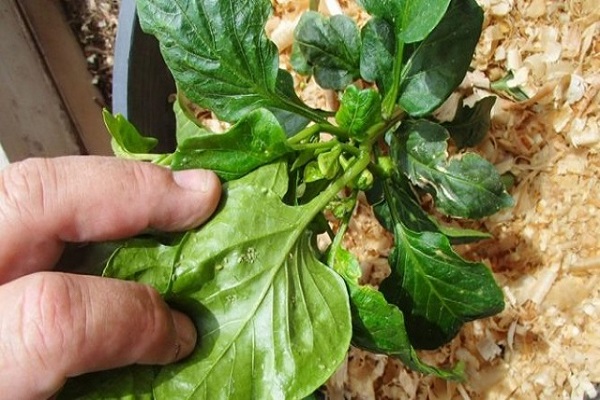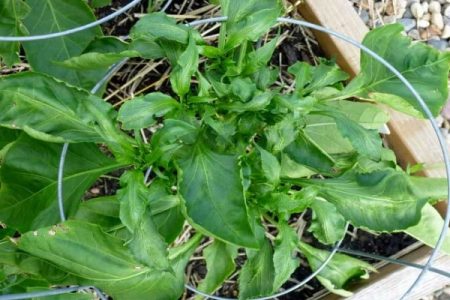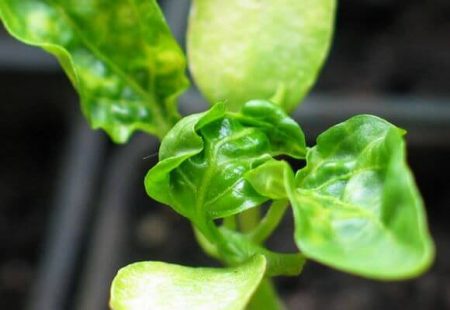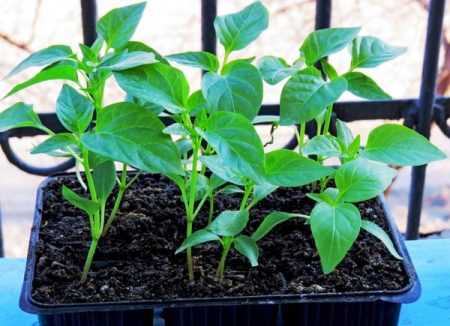 Pepper is a heat-loving plant, loving moist moist loose nutrient soil, light and warm. Growing pepper through seedlings requires compliance with the rules of agricultural technology. One of the features of pepper seedlings during the growing season is the twisting of the upper leaves during the period of active growth.
Pepper is a heat-loving plant, loving moist moist loose nutrient soil, light and warm. Growing pepper through seedlings requires compliance with the rules of agricultural technology. One of the features of pepper seedlings during the growing season is the twisting of the upper leaves during the period of active growth.
How dangerous this is, and how this phenomenon will affect fruiting, interests vegetable growers who have encountered this pathology.
Content
What causes torsion?
Pepper seedlings may curl due to several reasons. With a decrease in temperature, an increase in acidity, and an increase in humidity due to the lack of drainage in young plants, various diseases begin that are reflected on the leaves.
Most often, this phenomenon occurs due to:
- uneven leaf growth, which is often observed in this culture;
- lack of trace elements in the soil;
- aphids and spider mites;
- Fusarium, in which at the initial stage begins the twisting of the lower leaves.

To determine what caused the pathology, you need to carefully examine the plants. Need to rate:
- temperature change during the day;
- air humidity level;
- dry soil;
- the presence of insects or cobwebs on plants;
- soil sterility;
- soil saturation with nutrients.
Any factor from this list can cause curl of leaves on seedlings of peppers.
When twisting is a natural process of vegetation
Twisted young leaflets up will be observed in seedlings of peppers when there are a lot of nutrients in the soil, but not enough heat and sunlight. From this, the plants begin to stretch, and the biochemical processes in the tender leaves slow down.
With an excess of nitrogen, the average leaf vein rapidly increases in length, and the cells of the leaf plate, due to a lack of light, do not have time to quickly divide. From this, there is a strong tension of the canvas, which caused twisting. After some time, the cells of the leaf plate become activated, begin to divide normally and form a full-fledged leaf, which will straighten and acquire a characteristic density and luster.
To solve the problem, you need to thin out the thickened plantings. This will increase access to sunlight. With a strong drop in temperature at night, the seedlings are insulated in the evening, covering it with some material that retains heat. If seedlings began to be grown early, putting it on a window with wooden frames that let in cold air, then you can close the window with a layer of polyethylene to create a greenhouse effect.
When to worry
The presence of insects or cobwebs on the stalk should alert. Pests that settle on seedlings pierce plant cells with their proboscis and drink juice from them, which causes signs of wilting and curling of the leaves.
It is necessary to test the sticky notes. The aphids that ants bring with them secrete sweet juice. She eats pepper juice and destroys the grown stems, gradually destroying the entire plant. If a cobweb is found inside the leafs rolled down, then a mite settled in the pot with the plant, which harms just like aphids.
When the outside of the plant is clean, the cause may be a violation of the development of the root system. Lack of drainage and watering with cold water lead to damage to the underground part of the plant, which affects the appearance of seedlings.
Leaf curl can occur due to fungal diseases that develop for various reasons. Fusariosis develops on seedlings of peppers if the seeds were infected with fungal spores. This infection lives in soil where tomatoes, cucumbers, legumes, or corn used to grow.
A fungal disease is dangerous for seedlings because it threatens to destroy the entire crop of peppers that originate on plants infected with fusarium at the beginning of the growing process. The mycelium spreads through the vessels to different parts of the stem, starting from the lower tiers of the leaves. According to this symptom, a fungal disease is easily distinguished from the natural twisting of leaves, which is observed only on the tops of pepper.
What measures should be taken when sprouting seedlings
Depending on the symptoms found, methods of protecting seedlings from death are chosen. If the insects caused the twisting, then the seedlings should be shed with intavir, diluting the ampoule or tablet in water, following the instructions. This will be enough to clear the pots of parasites. Most peppers will recover, and seedlings will continue to grow. Harvest will not suffer.
Finding Fusarium in seedlings will require strict quarantine measures. Seedlings will have to be destroyed, the pots washed and treated with a fungicide.
- In order not to lose seeds and seedlings, fungal diseases should be warned: Acquire soil in a store.
- When using its nutrient mixture, fry all components at a temperature of more than 60C until a haze appears.
- Spill the prepared soil with a dark solution of potassium permanganate or Fitosporin.
- Home seeds must undergo pre-sowing treatment with fungicide.
- If the leaves are curled due to lack of nutrients, then the peppers need to be treated with fertilizer with trace elements, and then powder them with wood ash. This will solve the problem of lack of potassium in the soil.
When the reason for the twisting of leaves of pepper seedlings in dry soil, which often happens in small pots that are close to heating appliances, you need to spray the leaves from the spray gun several times a day in addition to abundant watering. This increases humidity, reduces moisture deficiency and improves the appearance of plants.
Reviews
In their reviews, experienced gardeners share tricks to prevent leaf twisting.
Tatyana, Moscow Region: “I grow seedlings of peppers on the windowsill, under which there is a central heating battery. The earth dries quickly, and the leaves of the peppers curl. To solve this problem, in addition to irrigation with warm water, I regularly irrigate plants with clean water. After that, the leaves spread out and begin to shine. ”
Ivan, North Caucasus: “The curl of pepper seedlings is sometimes observed only due to sudden changes in temperature. I use home soil from black soil, oven ash, vermiculite and peat for growing pepper. Add potassium nitrate at the rate of 1 tbsp. 5 liters of soil to improve nutrition. ”
Valery, Crimea: Sometimes I observe twisting of leaves during thickened plantings. Then I break through the seedlings, leaving 2-3 cm between the sprouts. This is enough for the plants to receive the necessary lighting. If the leaves still twist, I check the temperature, and cover the seedlings at night to keep it warm. "




 Calorie pepper stuffed with meat and rice - BZHU per 100 grams
Calorie pepper stuffed with meat and rice - BZHU per 100 grams Gorky pepper - the best varieties for open ground
Gorky pepper - the best varieties for open ground Hot pepper seeds - the best varieties for open ground and reviews
Hot pepper seeds - the best varieties for open ground and reviews Capsicum tincture for hair - how to use and reviews
Capsicum tincture for hair - how to use and reviews